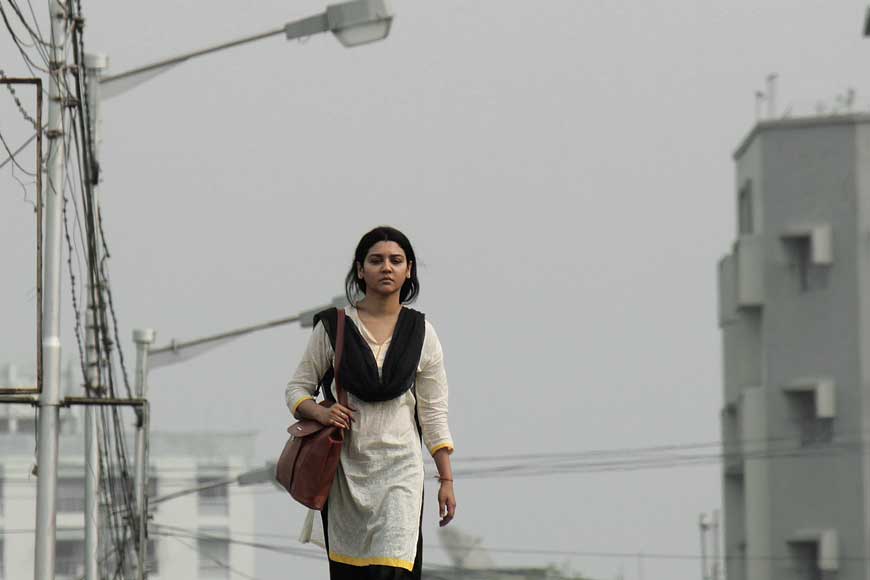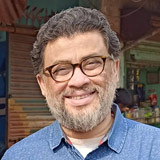Bhalobashar Shohor City of Love

1. The story line of Bhalobashar Shohor revolves around Annapurna, a Hindu girl from Kolkata, who falls in love with Adil Hussain, a Muslim man working in Homs in Syria. Did you consciously marry a Hindu girl to a Muslim boy? Did you have the world audience in mind for your film while selecting this theme?

Well, Annapurna could have been a Bengali Muslim girl who elopes to Syria with her Muslim lover. But to portray the massive reach and impact of the Syrian tragedy, I wanted the storyline to be more hard-hitting, bringing in an inter-community alliance. Had both been Muslims, somewhere I feel, impact would have been less.
I wanted both the national and international audience to watch the movie since I think the issue is global.
2. Why have you brought Syria into the narrative? Neither Homs nor Kolkata has any direct link with the storyline, except that they are two cities. Which according to you is Bhalobashar Shohor?
Both are Bhalobashar Shohor. Both have residents who have warmth, love and who lived in harmony once. Both cities are old, with citizens who are emotional, love music, and have a rich past. Historically, they are connected. I was literally obsessed with Syria, used to watch news every night to visualize the destruction that turned a thriving old civilization to ruins, shattering lives and dreams. India somewhere survived the test of time being a democracy, Syria could not. With 50 years of dictatorship, it crumbled and gave way to civil war, with almost 17 political factions.
No city in the world has been as badly destroyed as Syria. India and Kolkata also suffers from several fault lines today, like manufactured nationalism, parallel radicalism and inter-community conflicts, that could have led to civil wars. Thankfully it didn’t.
If one traces history of the recent Syrian crisis, one will realize, a huge area between Tigris and Euphrates was devastated by a famine between 2006 and 2010. Almost 40% of the rural population lived there and it was the bread basket. These people were forced to migrate to city fringes where they lived under inhuman conditions, without toilets and drinking water. Thanks to the monsoon, Indian cities are usually saved from such migrations. But with global warming on the rise, a day might soon come, when such migrations leading to conflict can take place in any Indian city including Kolkata. So, somewhere Syria and Kolkata came into the frame.
3. There are two distinct narratives in the movie. One, where you have taken a liberal route to establish an association between people of two religions. Another, where Annapurna kills her daughter and thereby puts an end to the liberal canvas. Why did you do that?
I tried to relate the visual destruction of a city with the emotional destruction of a woman. It is almost like a visual metaphor, where Annapurna loses her husband to the Syrian bombings and returns with a maimed child to Kolkata, only to realize that her child might never come out from a coma.

4. Except for the opening song by a young girl, the entire movie is dark and morbid. Why didn’t you explore the possibility of a silver lining?
The opening song has a story behind it. I have a niece who has a habit of running around the house and singing. One day my sister recorded her song. Right then I realized there might have been another child who sang in Syria but got killed by thoughtless bombing. So, I started the movie with a song. Tragedy is beyond numbers and boundaries. Syria is a symbol of a civilization that is being annihilated. It could have happened to any other city. To reflect the extent of destruction, I did not bring in any element of silver lining or hope.
5. By killing her comatose daughter, Annapurna somewhere kills the Adil in her too. In the process did you deliberately kill the love between them?
Yes, I tried to kill the narrative. For every day, I find a phenomenally possible world is being throttled, being destroyed. Humans could have lived peacefully and happily, but we are just destroying everything. Thus, that love also gets killed through Annapurna.
6. Annapurna is seen struggling in Kolkata to make both ends meet and eventually kills her daughter, whose treatment needs a lot of money that she cannot afford. Kolkata did not allow her to live with dignity in your film. Why was it so, when millions try to survive in this City of Joy?
The scene of a mother killing the child is a symbol of unrelenting tragedy. It can only reflect the grave situation of Syria. We too are surrounded by so much violence and insensitivity. Two friends talking, are turning abusive on a simple matter of difference, school children murdering their classmates. It is not just a mother’s personal act; but a reflection of our times.

7. Your last shot shows Kolkata merging with a Syrian city bombarded and destroyed. Do you foresee a destructive Kolkata in the future?
As I said before such man-made destruction can take place anywhere in the world anytime.
8. Your film has the canvas of a large format feature film, in subject, making, production design etc. But it somehow ended up being a short film. Was it a budget constraint or a conscious effort?
No, I wished to do a short film. I believe Bengali movies are no longer feasible to run in big halls. So, for an independent voice, internet is the best platform.
9. The film is getting appreciation. Do you want to be labeled as a short film, low budget film maker?
I opted for low budget for practical reasons. I tried reverse crowd funding as it helps in creative liberty. It was like a litmus test for me where I expected viewers to support or validate, rather than direct funding. And I have got a reasonable donation with more than 1.5 lakh views.
10. Prabuddha Banerjee, music director and sound designer of your film. Did his music and sound relate to the theme?
Prabuddha and I worked in Phoring too. We understand each other’s requirements and he has certainly matched the sound, I thought would best suit the film. Budget was a constraint but also since we interact on so many film related issues and his understanding of sound is so mature, I thought he would do a great job, which he did.
11. Story lines can change over time, but have you shown many free-thinking film makers a roadmap to communicate through this format?
I am convinced that internet is the only platform where any free-thinking person can communicate easily. Bhalobashar Shohor has substantiated my conviction and I am already planning my next film for the online platform. I suppose amidst all the dark elements in the film as being perceived by many, I can certainly see the light at the end of the tunnel and that is hope for me.
(Prabuddha Banerjee’s musical anecdotes for Bhalobashar Shohor will soon follow. Watch out!)










